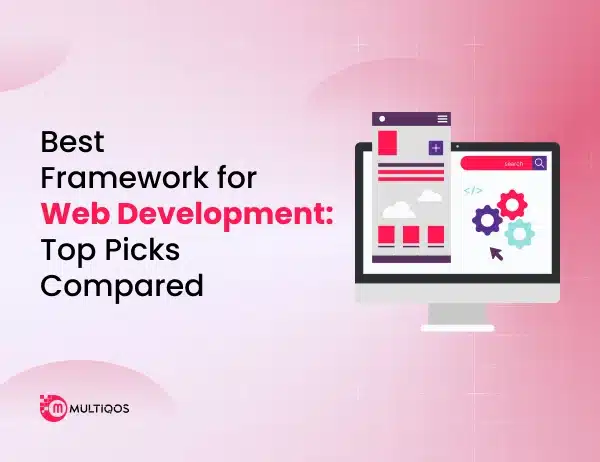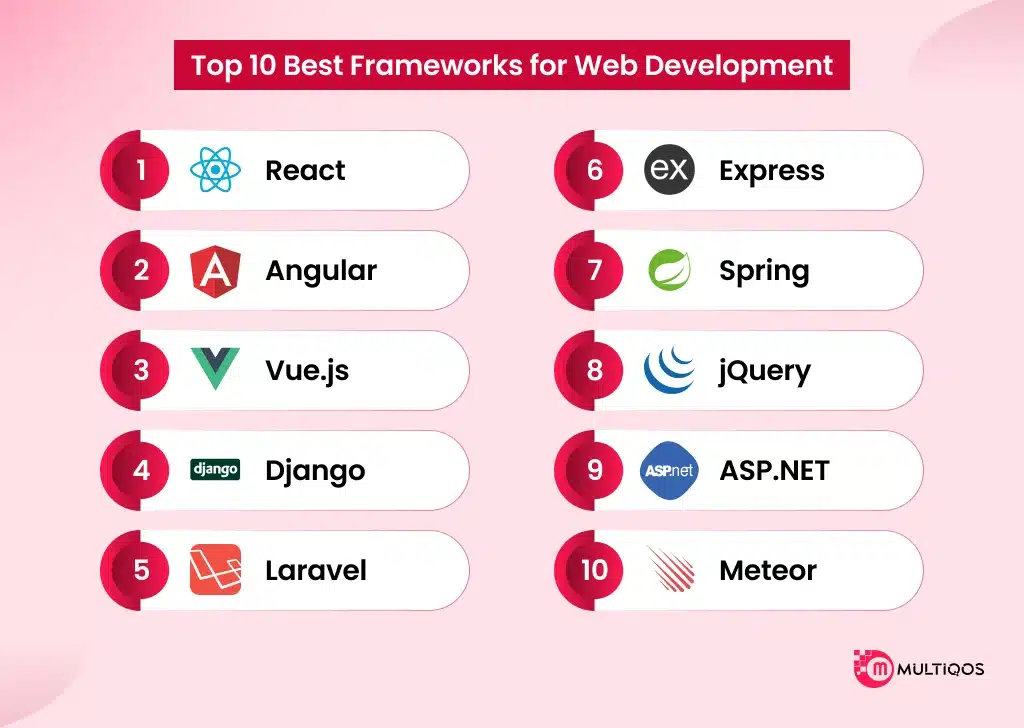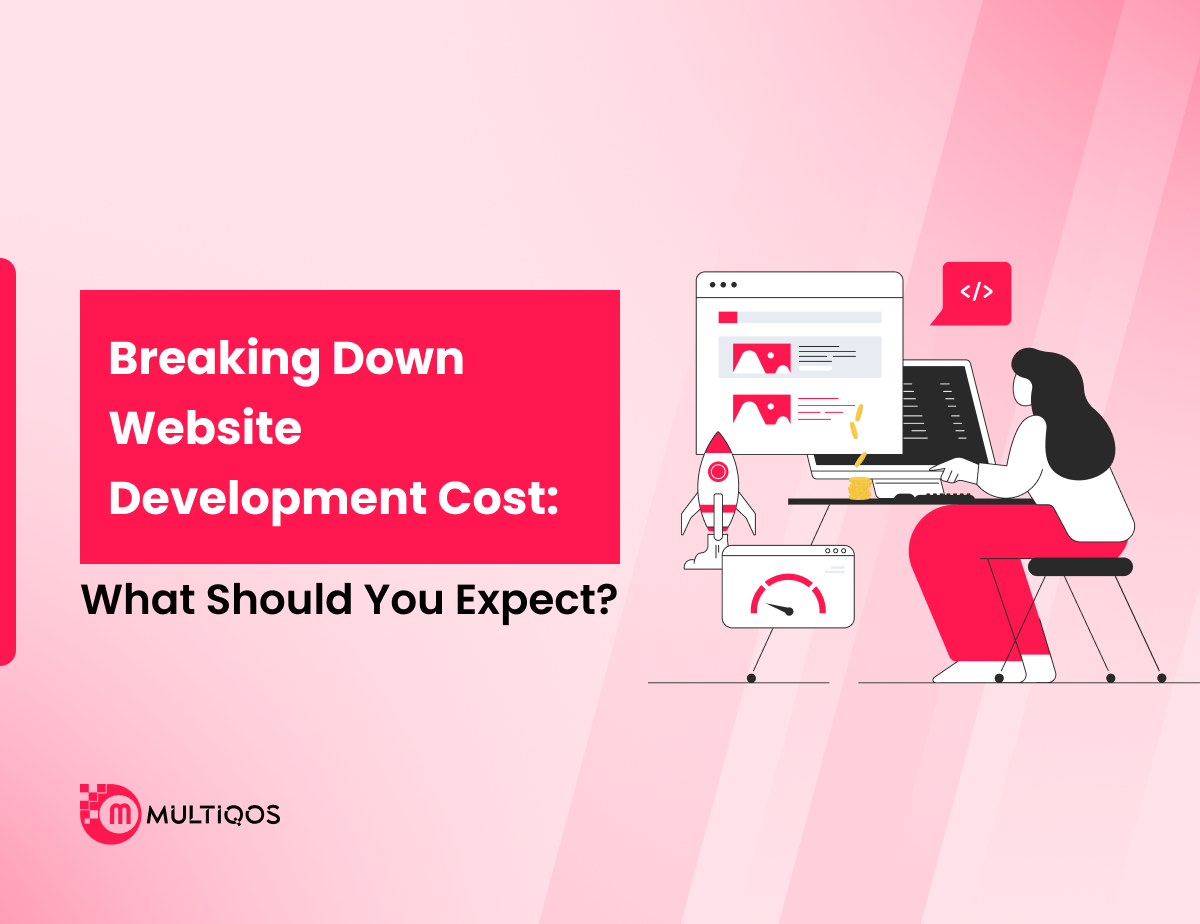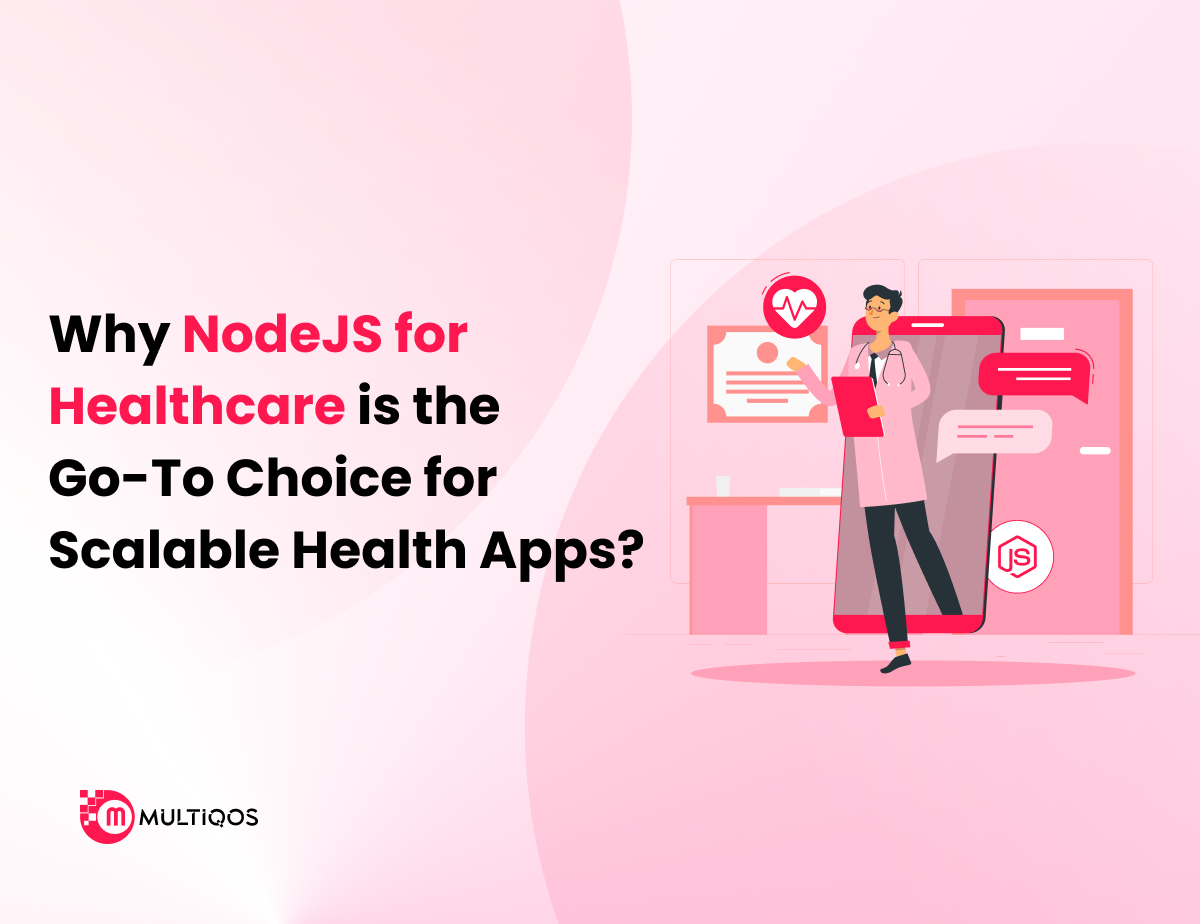Best Framework for Web Development: Top Picks Compared

Table of Contents
Summary:
The right framework is crucial for efficient, scalable, and maintainable web development. In this blog, we compare the top web development frameworks—such as React, Angular, Vue.js, Django, and Laravel—highlighting their strengths, weaknesses, ideal use cases, and performance.
Whether you’re building a dynamic single-page app or a robust backend API, this guide will help you find the best framework for web development to match your project’s needs and goals.
Introduction
Choosing the best web development frameworks can be quite perplexing due to the myriad available frameworks, each claiming to have the best use case scenarios. Whether you are dealing with a new frontend or backend application, full-stack systems, or microservices, a well-chosen framework can aid with faster implementation, better resource utilization, and lower maintenance overhead.
This blog discusses various new and advanced frameworks, from the ever-popular React, Angular, and Vue.js to the powerful backend Django and Laravel. It provides a level understanding of tradeoffs for each framework to enable easier selection for the user’s subsequent projects.
Top 10 Best Frameworks for Web Development
Picking the right framework is highly important to achieving fast, scalable, and maintainable web applications. With features ranging from front-end frameworks to back-end powerhouse frameworks, here is a list of the top web development frameworks with their corresponding features and specific use cases.
1. React
React is one of the most practiced and acknowledged libraries for UI development, especially for single-page applications (SPAs). It makes it easier for developers to maintain and construct an application by permitting the splitting of complex UIs into simpler and reusable components.
React is very fast in comparison with traditional approaches and makes dynamic content updates lightning fast due to its advanced ecosystem, tools such as Next.js and enterprise platforms, as well as Redux for state management. The user community is very large, which enables rapid changes, many documents and guides, as well as powerful third-party plugins.
2. Angular
For constructing highly sophisticated single-page applications, Angular, as an open-source framework, best serves the purpose. Being different from React, Angular’s flexibility is restrained to certain areas which serve the developer’s needs, like dependency injection, form validation, routing, or even HTTP services. Considering TypeScript as the framework’s base (which is a superset of JS with static typing), the overall software quality is enhanced due to reduced complicated code issues and increased ease of maintenance.
Angular is aids well in aiding large applications where the users depend on architectural integrity, organization uniformity, and tool suite standardization, despite it being harder to master than the other frontend frameworks compared to it.It remains their go-to preference because of how easy it is for enterprise-grade teams to integrate, expand, and customize with the modular architectural design.
3. Vue.js
Vue.js is a flexible and simple JavaScript framework that is widely used because of its simple nature and ease of use. Whether you’re looking to enhance features in existing projects or develop complex applications from the ground up, this framework can be efficiently used. A developer is enabled to efficiently create multihandled interfaces through the responsive data binding systems and user-friendly component frameworks.
Backend development services that augment Vue, like routing taught using Vue Router and state management taught using Vuex, ensure that it meets the growing demands of the project. With an extensive guide or documentation and a smooth learning path, this framework becomes an excellent option for developers looking for a quick and modern framework to work on.
4. Django
You’ll be surprised to know that developers highly prefer working with Django when it comes to backend web development. This Pything framework helps to boost development speed, maintain high-end security, and ensure software quality assurance in the codebase. It is optimal for complex data-centric web applications as it promotes flexible design structures, maintainable code, and reusable components.
Many secure applications prefer the Django framework because of its protection against numerous SQL injections and cross-site scripting threats. Ranging from social networks and content management systems to scientific portals, Django supports a variety of high-performing web platforms.
5. Laravel
Laravel: a framework for PHP which arranges the logic of web applications in a clean and human-friendly way. It is helpful in doing a number of repetitive activities like routing user of the application, logging in the user, session management and caching of data. This is a best framework for web development that offers a variety of built-in form tools and a user-friendly command line, which makes scaffolding, database migrations, and other streaming activities much easier.
The community surrounding Laravel is incredibly huge. This community actively participates by modernizing its architecture and even creating other tools like Forge, Envoyer, and Vapor for server deployment. Laravel’s extensive ecosystem is a boon for developers because it offers a variety of excellent development solutions.
6. Express
An API backend framework that offers web applications in a sleek, minimalistic design is Express. It operates over the Node.js platform. Express allows developers to organize their applications in any way they want without forcing particular standards. Express handles HTTP requests, routing, and middleware integration with ease, which is a big plus for building RESTful APIs, microservices, or SPA backends.
When combined with frontend frameworks, Express’s speed and flexibility position it at the core of full-stack JavaScript development. Its widespread popularity among developers means there’s abundant documentation, plugins, and real-world examples, making it a smart option for businesses looking to hire web developers who can build efficient and scalable web applications.
7. Spring
Spring is a modular backend framework specialized for enterprise Java applications. With its comprehensive infrastructure, Spring helps developers secure, scale, and modularize web applications and services. Spring Boot, one of its components, takes configuration further by streamlining it and expediting deployment so production-grade applications can be built with minimal effort.
The framework facilitates dependency injection, manages transactions, and has a microservices architecture, which is beneficial for high-performance financial, health, and telecommunication applications. Additionally, it offers customizable constructs that are dependable, long-lasting, and scalable, making it favorable for Java developers.
8. jQuery
For the past 17 years, jQuery has remained one of the oldest JS libraries used for frontend development. In comparison to modern-day frameworks such as Angular and React, its usage has undoubtedly dwindled. Be that as it may, jQuery continues to be used with basic projects, websites, and legacy systems due to its ease of use and lightweight properties. With jQuery, developers have greater productivity with less code because the library greatly simplifies AJAX calls, animation, event handling, DOM manipulation, etc.
Through their multiple plugins, which can be easily plugged in, developers can add features without the need for external tools. For teams managing old codebases, jQuery aids in providing reliability and value while maintaining older frameworks. Moreover, jQuery can be helpful for smaller websites and for speedy prototypes.
9. ASP.NET
ASP.NET, an extremely versatile framework and a widely used framework for building web apps. It is the most recent addition to the .NET framework family and supports a wide range of programming languages. Functionalities like routing, model binding, and even validation and authentication are integrated within the framework. The current framework, ASP.NET, features a modular structure, cross-platform availability, and improved performance.
Its scalability and capacity for security integration make it especially easy to merge with Microsoft technologies like Microsoft Azure. That’s why mid to large enterprises in financial services, healthcare, and even government turn to ASP.NET as it’s easy to use, has a reputation for being extremely reliable, and also has countless development tools.
10. Meteor
Meteor is a comprehensive framework for JavaScript that seeks to simplify the entire process of developing web and mobile applications. Developers can build both client and server applications in one language, reducing the challenges faced during the development process.
Besides that, Meteor is compatible with MongoDB and can function alongside some UI libraries like Blaze and React. You can seamlessly create responsive and dynamic apps, which makes Meteor a best framework for web development even if you’re a startup.
Conclusion
The choice of the best framework for web development completely depends on your specific project requirements, the skillset of the developers, and project goals. For instance, if a project demands a dynamic UI, competing frameworks like React can be used. For secure backend functionality, Django can serve the purpose, while Laravel remains a contender for backend PHP framework development. All mentioned frameworks have their own advantages, catering to specific industry problems.
To make educated choices when choosing the right framework for the job, partnering with a trusted web development company can help accelerate your project. With the appropriate partner, any vision a person has can be turned into a scalable, high-performing web solution regardless of the complexity.
Frequently Asked Questions
A web development framework is the integration of multiple software applications, tools, and documents that assist in the construction of a website or web application. The framework streamlines website design, request handling, and data handling, which increases the developers’ work efficiency, further enhancing coding scalability.
Vue, React, and Angular are some of the best frameworks for frontend development to build interfaces and manage user interactions.
While choosing the right framework, make sure to consider your team’s level of expertise and the project’s complexity, performance requirements, and scalability.
No, but using a framework can minimize tedious tasks, enhance code quality, and declutter computer files. Developers can save time because frameworks are published with a wide range of functions that can be utilized during system creation from potential APIs, as well as for Security and System Growth. Though one can build from scratch, frameworks give a lot of assistance in production and maintenance work.
When you choose to hire web developer, look for proficiency in HTML, CSS, JavaScript, and backend languages like PHP, Python, or Node.js. Experience with frameworks, version control (e.g., Git), responsive design, and cross-browser compatibility.
Get In Touch







